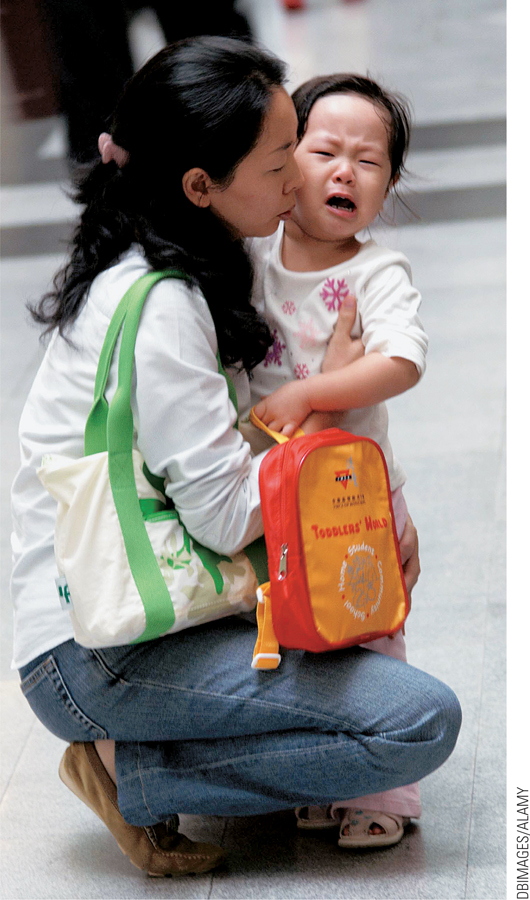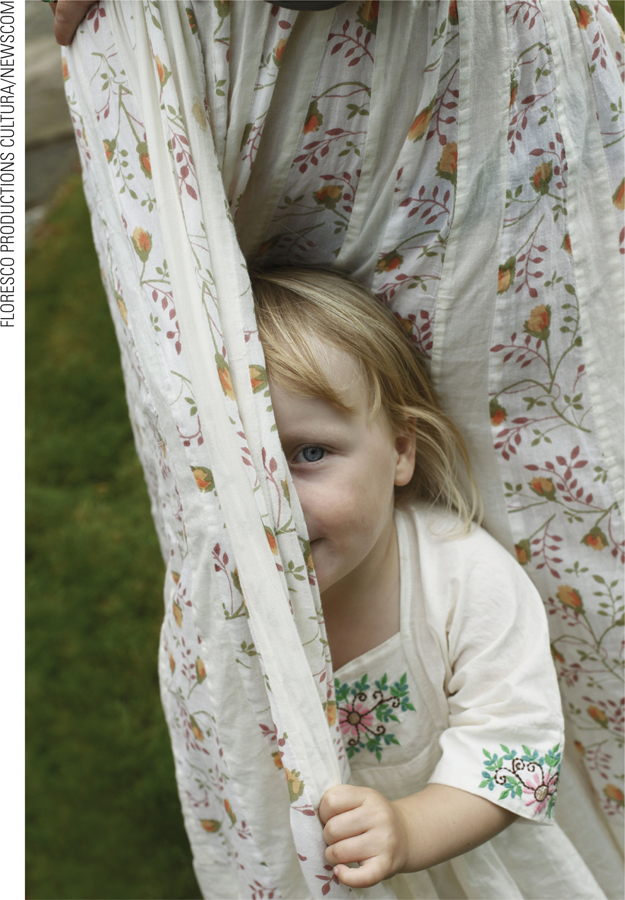Emotional Development

Children gradually learn when and how to express emotions, becoming more capable in every aspect of their lives. Controlling the expression of emotions, called emotional regulation, is the preeminent psychosocial task between ages 2 and 6. Emotional regulation is a lifelong endeavor, affected by temperament and time, but early childhood is a crucial period for its development (Gross, 2014; Lewis, 2013). Difficulty with emotional regulation predicts many psychosocial problems later on.
Such regulation is virtually impossible in infancy, but when the emotional hot spots of the limbic system connect to the prefrontal cortex, children become better able to control their reactions. This is not easy; it requires practice, maturation, and work, called effortful control (Eisenberg et al., 2014).
By age 6, children can usually be angry but not explosive, frightened but not terrified, sad but not inconsolable, anxious but not withdrawn, proud but not boastful. Depending on each child’s temperament, some emotions are easier to control than others, but even temperamentally angry or fearful children can learn to modify the expression of their emotions (Moran et al., 2013, Tan et al., 2013).
Emotional regulation is a lifelong necessity; no one does it perfectly all the time. When Rachel dropped the orange juice, I should not have yelled. Fortunately, my unregulated expression of anger stopped there. Learning to regulate emotion is a long process.
Initiative Versus Guilt
During Erikson’s third developmental stage, initiative versus guilt, children acquire many skills and competencies in addition to emotional regulation. Initiative can mean several things—
Usually, North American parents encourage enthusiasm, effort, and pride in their 2-
Protective Optimism
OBSERVATION QUIZ Does this mother deserve praise?
Yes—
Adults may think that children should have an accurate view of their abilities. But that is not typical of preschool children, nor should it be. Children are proud of themselves, optimistically overestimating their prowess. That helps them try new things, which advances skills of all kinds. As Erikson predicted, their optimistic self-

Children’s beliefs about their worth require first a sense that they are a person (self-
Remember that Erikson described autonomy at ages 1 and 2, a stage often characterized by stubbornness and nicknamed “the terrible twos.” By age 3, autonomy is transformed to become initiative, as children act on their eagerness to learn new skills (Rubin et al., 2009). This chapter’s opening anecdote is an example: Rachel was learning to get juice when she was thirsty. Both autonomy and initiative are more prized in Western cultures than in Eastern ones, where children learn to be socially attuned and interdependent (Keller & Otto, 2011).
Children in North America and Europe develop a strong self-
In the United States, self-
Erikson recognized that young children are not realistic. They believe that they are strong, smart, and good-
For instance, young children not only believe that their nation and religion are best; they feel sorry for children who do not belong to their country or church. At this age, a protective optimism encourages children to try unfamiliar activities, make friends, begin school, and so on (Boseovski, 2010). The same is true for mastering skills: They learn to pour juice, zip pants, and climb trees, undeterred by overflowing juice, stuck zippers, or a perch too high. Faith in themselves helps them persist.
Moreover, children are cognitively ready to understand group categories, not only of ethnicity, gender, and nationality, but even categories that are irrelevant, such as children whose names begin with the same letter. Such categories seem to be part of human thinking lifelong, so group identity appears spontaneously once the child is old enough. One amusing example occurred when preschoolers were asked to explain why one fictional creature would steal from another. They immediately suggested a reason, as you would expect from theory-
“Why did a Zaz steal a toy from a Flurp?”
“Because he’s a Zaz, but he’s a Flurp. They’re not the same kind….
“Why did a Zaz steal a toy from a Zaz?
“Because he’s a very mean boy.”
[Rhodes, 2013, p. 259]
Brain Maturation

The new initiative that Erikson describes results from myelination of the limbic system, growth of the prefrontal cortex, and a longer attention span—
Normally, neurological advances in the prefrontal cortex at about age 4 or 5 make children less likely to throw tantrums, pick fights, or giggle during prayer. Throughout early childhood, violent outbursts, uncontrolled crying, and terrifying phobias (irrational, crippling fears) diminish. The capacity for self-


Video Activity: Can Young Children Delay Gratification illustrates how most young children are unable to overcome temptation even when promised a reward for doing so.
For example in one study, researchers asked children to wait 8 minutes while their mothers did some paperwork before opening a wrapped present in front of them (Cole et al., 2011). The children used strategies to help them wait, including distractions and private speech.
Keisha was one of the study participants:
“Are you done, Mom?” … “I wonder what’s in it” … “Can I open it now?”
Each time her mother reminds Keisha to wait, eventually adding, “If you keep interrupting me, I can’t finish and if I don’t finish …” Keisha plops in her chair, frustrated. “I really want it,” she laments, aloud but to herself. “I want to talk to mommy so I won’t open it. If I talk, Mommy won’t finish. If she doesn’t finish, I can’t have it.” She sighs deeply, folds her arms, and scans the room…. The research assistant returns. Keisha looks at her mother with excited anticipation. Her mother says, “OK, now.” Keisha tears open the gift.
[Cole et al., 2011, p. 59]
According to a longitudinal study of preschoolers who managed to wait before eating a marshmallow in order to get two marshmallows, the ability to delay gratification correlates with success in adulthood (Mischel, 2014).
Motivation
Motivation (the impulse that propels someone to act) comes either from a person’s own desires or from the social context.
Intrinsic motivation comes from within, when people do something for the joy of doing it: A musician might enjoy making music even when no one else hears it. Intrinsic motivation is thought to advance creativity, innovation, and emotional well-
Extrinsic motivation comes from outside, when people do something to gain praise or another reinforcement. A musician might play for applause or money. Humans seek such external rewards, but if the reward stops, the behavior stops.
Especially for College Students Is extrinsic or intrinsic motivation more influential in your study efforts?
Both are important. Extrinsic motivation includes parental pressure and the need to get a good job after graduation. Intrinsic motivation includes the joy of learning, especially if you can express that learning in ways others recognize. Have you ever taken a course that was not required and was said to be difficult? That was intrinsic motivation.
Intrinsic motivation is crucial for young children, with almost all of them playing, questioning, and exploring for the sheer joy of it. That serves them well. A study found that 3-
Child-
Intrinsic motivation is apparent when children invent dialogues for their toys, concentrate on creating a work of art or architecture, and converse with imaginary friends. Such conversations with invisible companions are rarely encouraged by adults (i.e., no extrinsic motivation), but from about age 2 to 7, imaginary friends are increasingly common. Children know their imaginary friends are pretend, but conjuring them up meets intrinsic needs (M. Taylor et al., 2009).
Especially for Teachers One of your students tells you about a child who plays, sleeps, and talks with an imaginary friend. Does this mean that that child is emotionally disturbed?
No, unless the child is over age 10. In fact, imaginary friends are quite common, especially among creative children. The child may be somewhat lonely, though; you could help him or her find a friend.
In a classic experiment designed to understand more about why children do what they do, preschool children were given markers and paper for drawing and assigned to one of three groups who received, respectively: (1) no award, (2) an expected award (they were told before they had drawn anything that they would get a certificate), and (3) an unexpected award (after they had drawn something, they heard, “You were a big help,” and got a certificate) (Lepper et al., 1973).
Later, observers noted how often children in each group chose to draw on their own. Those who received the expected award were less likely to draw than those who were unexpectedly rewarded. The interpretation was that extrinsic motivation (condition #2) undercut intrinsic motivation.
This research triggered a flood of studies seeking to understand whether, when, and how positive reinforcement should be given. The consensus is that praising or paying a person after an accomplishment sometimes encourages that behavior. However, if payment is promised in advance, that extrinsic reinforcement may backfire (Deci et al., 1999; Cameron & Pierce, 2002; Gottfried et al., 2009).
Especially for Teachers of Young Children Should you put gold stars on children’s work?
Perhaps, but only after the work is completed and if the child has put genuine effort into it. You do not want to undercut intrinsic motivation, as happens with older students who know a particular course will be an “easy A.”
Praise is effective when it is connected to the particular production, not to a general trait. For example, the adult might say, “You did a good drawing,” not “You are a great artist.” The goal is to help the child realize that effort paid off, which motivates a repeat performance (Zentall & Morris, 2010).
In another set of experiments that suggest that specific praise for effort is better than generalized statements, some 4-
Culture and Emotional Control

As you know, cultural differences are apparent in every aspect of development. This is quite obvious in emotional expression. Children may be encouraged to laugh/cry/yell or the opposite, to hide those emotions. Some adults guffaw, slap their knees, and stomp their feet for joy; others cover their mouths with their hands if a smile spontaneously appears. Children learn to do the same.
Control strategies vary culturally as well. Peers, parents, and strangers sometimes ignore emotional outbursts, sometimes deflect them, sometimes punish them. Shame is used when social reputation is a priority. In some cultures, “pride goeth before a fall” and people who “have no shame” are considered mentally ill (Stein, 2006).
Finally, families, cultures, and nations differ as to which emotions most need to be regulated. Cohort changes and social stereotypes distort any attempt to link specific nations with the emotions each attempts to regulate, but the following illustrates the idea of cultural variations:
Fear (United States)
Anger (Iran)
Pride (China)
Selfishness (Japan)
Impatience (many Native American communities)
Defiance (Mexico)
Moodiness (the Netherlands)
(Chen, 2011; Harkness et al., 2011; J. G. Miller, 2004; Stubben, 2001; Tahmouresi et al., 2014).
Temperaments vary, which makes people within the same culture unlike one another. “Cultures are inevitably more complicated than the framework that is supposed to explain them” (Harkness et al., 2011, p. 92). Nonetheless, parents everywhere teach emotional regulation, hoping their children will adapt to the norms of their culture, and cultures differ in which emotions are particularly unwelcome (Kim & Sasaki, 2014).
Seeking Emotional Balance
Universally, at every age, in all cultures and cohorts, caregivers try to prevent psychopathology, an illness or disorder (-pathology) of the mind (psycho-
Without adequate regulation, emotions are overwhelming. Intense reactions can occur in opposite ways, as you might expect from the activate/inhibit nature of neurons, as explained in Chapter 8.
Some people have externalizing problems: Their powerful feelings burst out uncontrollably. They externalize rage, for example, by lashing out or breaking things. Without emotional regulation, an angry child might pummel another person or lie down screaming and kicking. By age 5, children usually have learned more self-
Other people have internalizing problems: They are fearful and withdrawn, turning distress inward. Emotions may be internalized via headaches or stomach aches. Although the cause is psychological, the ache is real. Girls tend to internalize and boys to externalize, although children of both sexes do both.
With maturity, the extreme fears of some 2-


Both undercontrol, which produces externalizing behavior, and overcontrol, which leads to internalizing behavior, are much more common in 3-
Sex differences in internalizing and externalizing behavior are traditionally assumed to be biological, perhaps hormonal, but a cultural explanation is also possible. Do parents and cultures teach young girls to restrain externalizing actions (“not ladylike”), while teaching boys to avoid crying (“be a man”)? Trying to understand the causes of sex or gender differences is a concern of thousands of researchers (Eagly & Wood, 2013). Conflicting theories and evidence are presented later in this chapter. In any case, unless they master emotional regulation during early childhood, boys tend to throw and hit and girls tend to sob or hide.
SUMMING UP Achieving emotional regulation is the crucial psychosocial task in early childhood. Erikson thought young children are naturally motivated to take initiative, with joy at new tasks. He also thought that during early childhood, guilt feelings may come to the fore, as parents criticize unrestrained emotional expression. As children develop their self-
WHAT HAVE YOU LEARNED?
Question 10.1
How might protective optimism lead to a child’s acquisition of new skills and competencies?
Young children's self–concepts are unrealistic. They believe that they are strong, smart, and good– looking— and thus that any goal is achievable. Whatever they are is thought to be good. This protective optimism encourages children to try unfamiliar activities, make friends, begin school, and so on. Question 10.2
How would a child’s self-
concept affect his or her motivation? Because young children believe that they are strong, smart, and good–looking, they believe that any goal is achievable. Thus, a strong self– concept enhances motivation. Question 10.3
What is an example of an intrinsic motivation for reading?
An intrinsic motivation for reading a book would be finding enjoyment from reading.Question 10.4
What is an example of an extrinsic motivation for reading?
An extrinsic motivation for reading a book would be getting paid by one's parents for reading books during summer break.Question 10.5
What seem to be sex differences in externalizing and internalizing behavior?
Sex differences in internalizing and externalizing behavior are traditionally assumed to be biological, perhaps hormonal, but a cultural explanation is also possible. Do parents and cultures teach young girls to restrain externalizing actions (“not ladylike”), while teaching boys to avoid crying (“be a man”)? Trying to understand the causes of sex or gender differences is a concern of thousands of researchers.Question 10.6
What is the connection between psychopathology and emotional regulation?
Impaired emotional regulation universally signals psychopathology, an illness or disorder of the mind. Without adequate regulation, emotions can be overwhelming. Intense reactions can occur in opposite ways, as you might expect from the activate/inhibit nature of neurons. Some people have externalizing problems: Their powerful feelings burst out uncontrollably. Without emotional regulation, an angry child might flail at another person or lie down screaming and kicking. Other people have internalizing problems: They are fearful and withdrawn, turning distress inward. Internalized emotions may exhibit themselves as headaches or stomachaches.Question 10.7
What is universal and what is culture-
specific in emotional expression? All children experience basic emotions, such as happiness, fear, and anger. However, cultural differences are apparent in every aspect of development. This is quite obvious in emotional expression. Children may be encouraged to laugh/cry/yell or the opposite, to hide those emotions. Some adults guffaw, slap their knees, and stomp their feet for joy; others cover their mouths with their hands if a smile spontaneously appears. Children learn to do the same. Control strategies vary culturally as well. Peers, parents, and strangers sometimes ignore emotional outbursts, sometimes deflect them, sometimes punish them. Shame is used when social reputation is a priority. In some cultures, “pride goeth before a fall” and people who “have no shame” are considered mentally ill. Finally, families, cultures, and nations differ as to which emotions most need to be regulated.